- Region
- Vega baja
- Marina Alta
- Marina Baixa
- Alicante
- Baix Vinalopo
- Alto & Mitja Vinalopo
-
ALL TOWNS
- ALICANTE TOWNS
- Albatera
- Alfaz Del Pi
- Alicante City
- Alcoy
- Almoradi
- Benitatxell
- Bigastro
- Benferri
- Benidorm
- Calosa de Segura
- Calpe
- Catral
- Costa Blanca
- Cox
- Daya Vieja
- Denia
- Elche
- Elda
- Granja de Rocamora
- Guardamar del Segura
- Jacarilla
- Los Montesinos
- Orihuela
- Pedreguer
- Pilar de Horadada
- Playa Flamenca
- Quesada
- Rafal
- Redovan
- Rojales
- San Isidro
- Torrevieja
- Comunidad Valenciana
Iglesia de San Andrés Mazarrón
Mass is celebrated daily at the Church of San Andrés in Mazarrón
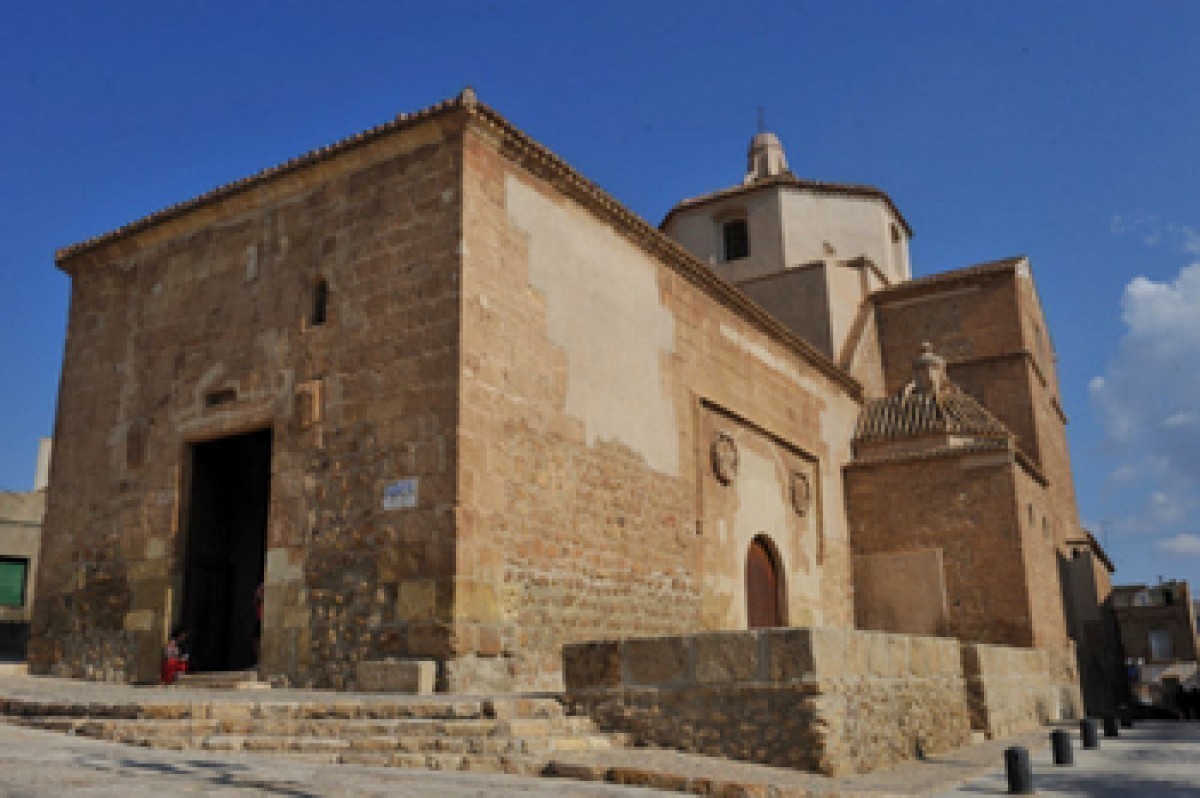 This is the church used most extensively for worship today within the town of Mazarrón and offers daily mass for those living in or visiting the town. (Mass is held in Spanish.)
This is the church used most extensively for worship today within the town of Mazarrón and offers daily mass for those living in or visiting the town. (Mass is held in Spanish.)
Don't be misled by the broken tile plaque outside the door. This church is within the Cartgena Diocese and the parish of San Anton de Padua, and although it is the Iglesia de San Andrés visitors could easily be mistaken into thinking they were at the wrong church as the tiles seem to indicate that this is the church of San Antón.
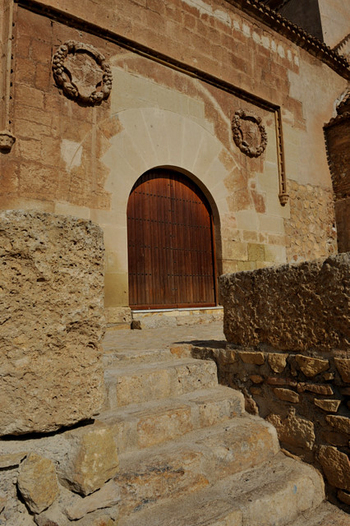 This is a structurally simple but historic church, standing in a privileged position on the outskirts of the old town in Mazarrón, surrounded by stone paving and gardens.
This is a structurally simple but historic church, standing in a privileged position on the outskirts of the old town in Mazarrón, surrounded by stone paving and gardens.
The building still boasts one of the few surviving Mudéjar (or late Moorish) style wooden ceiling frameworks in the Region of Murcia, specifically a wooden structure which is very similar to the one which can be admired in the Templo de la Santa in Totana.
History behind the Parroquia de San Andrés
The "villa" of Mazarrón came under the ecclesiastical jurisdiction of Lorca at the time of its independence as a municipality in 1572. The two main population centres of Mazarrón, the town and the port, were governed by the Marqués de los Vélez and the Duke of Escalona, of the Villena family, who owned the mining concessions in the hills behind the town.
The financial burden of building places of worship normally fell upon the noble families who held power in the towns, except where finances were available through contributions from the citizens. In the case of Mazarrón, the Vélez family were responsible for the church of San Antonio, while the Duke of Escalona was behind the construction of the church of San Andrés.
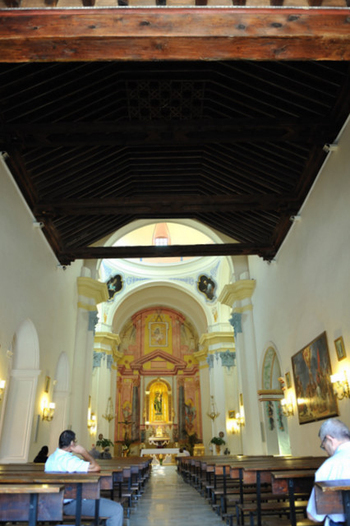 The exact date of its construction is uncertain, but to judge by the ashlar masonry around the south door and the details described by researchers such as Pérez Sánchez, the Church must have been built some time between 1523 and 1549.
The exact date of its construction is uncertain, but to judge by the ashlar masonry around the south door and the details described by researchers such as Pérez Sánchez, the Church must have been built some time between 1523 and 1549.
The building we see today is primarily the result of a reconstruction which was undertaken in 1762, when the transept was added. The old church must have been rectangular in shape with a wooden roof, and added chapels on each side.
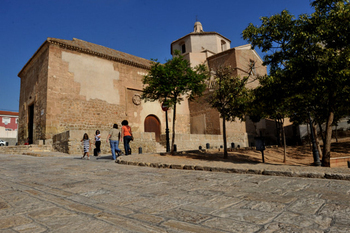 Inside the church the wooden ceiling is still visible, and it is still possible to appreciate the Mudéjar craftsmanship, which continued to be common until the 17th century. The framework consists of two main crossbeams and a central area (or "almizate") decorated with loops which form eight-pointed stars of two colours. Interlocking beams also show the decorative style typical of this type of construction.
Inside the church the wooden ceiling is still visible, and it is still possible to appreciate the Mudéjar craftsmanship, which continued to be common until the 17th century. The framework consists of two main crossbeams and a central area (or "almizate") decorated with loops which form eight-pointed stars of two colours. Interlocking beams also show the decorative style typical of this type of construction.
It is very distinctive, and contrasts strongly with the painted walls of the remainder of the church., and is a fine example of this type of ceiling.
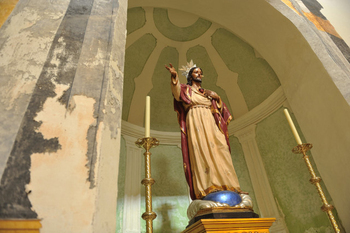 In the past the inside of the church would have been decorated with paintings, but the passage of time has eliminated all but the faintest traces of these decorations. Fortunately, the decorations have not been repainted, so the effect is of a homely and lived-in church, used on a daily basis, the paintings respected and held in deep affection rather than being garishly replaced with modern "renovations."
In the past the inside of the church would have been decorated with paintings, but the passage of time has eliminated all but the faintest traces of these decorations. Fortunately, the decorations have not been repainted, so the effect is of a homely and lived-in church, used on a daily basis, the paintings respected and held in deep affection rather than being garishly replaced with modern "renovations."
Outside the church it is worth noting the coats of arms which flank the main door:
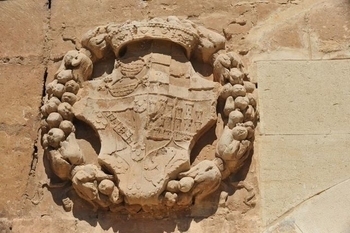 Escudo Marqués de Villena: the coat of arms belongs to the noble house of Villena, and this beautiful piece of masonry is to be found on the main façade of the church.
Escudo Marqués de Villena: the coat of arms belongs to the noble house of Villena, and this beautiful piece of masonry is to be found on the main façade of the church.
The Marquises de los Vélez y de los Villena owned properties in Mazarrón, and enjoyed the right to emblazon their arms on the doors of any and all of their houses. Among other prerogatives, they also received the title "Don", they were exempt from military service and they could not be imprisoned for debt.
Hours of Mass
 Summer
Summer
Monday to Saturday 20.00, Sundays 12.00 midday and 20.00
Winter
Mondays to Saturdays 19.00, Sundays 12.00 midday and 19.00
Parish offices: Tel. 968 592302
Address:
The Church is at the top of Plaza Ramón y Cajal, and the intersection with Calle Pablo Picasso. Click for map, Plaza Ramón y Cajal, Mazarrón.
There is parking in the surrounding streets but the easiest is in the old marketplace in front of the Iglesia de la Purísima, where Mass is celebrated on a Saturday evening. From here walk down towards the Town Hall and turn right up the side of the church of San Antón.
Click for further information about the Mazarrón municipality






































